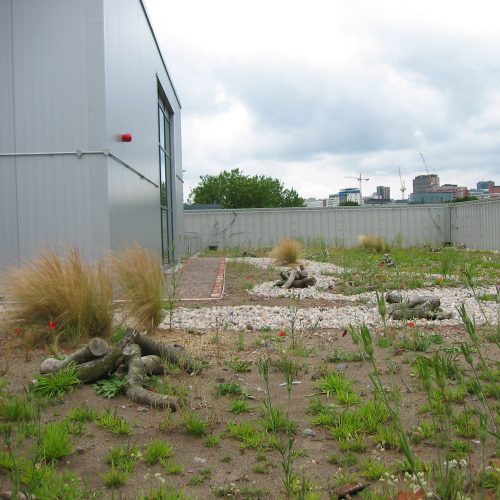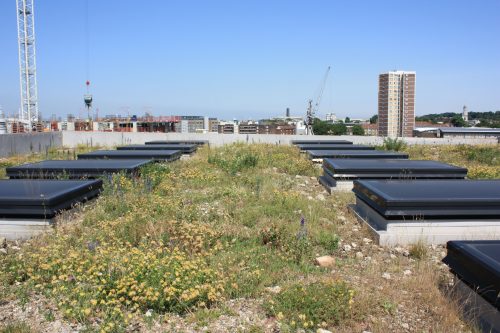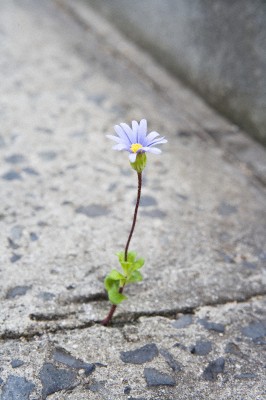This blog post is in response to my post last week, “I Am a Weed.”
Since a lot of Eco Brooklyn’s work involves creating ecological plant-scapes, the issue of weeds and native species arrises a lot. As an ecological landscaper we’ve learned that the only difference between a weed and a plant lies in the definition of the beholder. For example we plant a lot of native grasses, considered your archetypal weed to the typical green lawn installer. In general we tend to plant in a much more “wild way” than your typical landscape design.
We also plant in a lot more places than considered normal in a city – on roofs, walls, stairs and any other surface. By doing this we are aware that our work spreads a lot of native plants throughout the city through wind and bird droppings.
If cities were to increase their leniency toward spontaneous urban plants, how could they do so responsibly? There are some valid points to be made in the argument against weeds. Some plants, such as ragweed, cause allergic reactions. Others have the ability to completely dominate a landscape and kill off any other competing plants, like japanese knotweed. In a few rare cases, exotic spontaneous plants have brought in diseases or funguses that affect native plants. Dutch Elm Disease, which was actually introduced by an insect, not a plant, is the most infamous of these. It’s an impressive feat for a plant to survive in the crack of a building, but if it grows so large that it jeopardizes the building’s infrastructure then that is a problem. So where should these plants be grown and how?
A passive answer to this question are brownfields. Brownfields are abandoned or underused patches of land that once facilitated industrial or commercial activity. These unattended sites can quickly become inhabited by spontaneous plants and given free reign, soon grow into little forests, discreetly nestled within a city block. In these scenarios, an unsightly vacant lot morphs into a green field with zero human effort or money put into it.
A more proactive way of including spontaneous plants in our urban environments is via brown roofs. Brown roofs are very similar to green roofs. They share many of the same construction methods and benefits. The difference is that the dominant aim of a brown roof is to increase biodiversity, whereas green roofs tend to focus more on aesthetics. A green roof requires a certain amount of tending whereas a brown roof is purposely left undisturbed so that local wildlife can colonize it. In this unmanaged state, brown roofs offer hospitable land for the airborne seeds of spontaneous urban plants.
A brown roof can be seeded when it is first created or it can be designed to set up the proper conditions (i.e. a plantable substrate) for plant life to grow and then left to the forces of nature. In the latter scenario, it takes about two years for the brown roof to fully grow in. Although somewhat popular in Europe, because of the slow rate of return and lack of control over the roof garden’s aesthetic, brown roofs are very rare in the US. I think it is understandable to prefer a green roof on one’s home or in a public area, but I propose that large buildings like factories looking to cut down on energy costs consider building brown roofs as they will help insulate the building while requiring very little maintenance.

To clarify, although brown roofs can largely be left to themselves, they don’t and shouldn’t be left entirely untouched. Undesirable plants, such as those that cause allergies or are aesthetically unappealing, can be removed. Invasive plants should be pruned or taken out. What it comes down to is reconsidering “gardening” altogether, not just the plants being used. Recall land artist, Michael Heizer’s, work Double Negative (see “The Earth Art Movement”). Heizer makes us question whether something is art if it is created purely by subtraction. With a green roof or any other garden, we choose the plants and place them where we like– addition. However, a brown roof that is left to colonize itself can be developed simply by taking away plants– subtraction. Subtraction, in this case, is the less energy intensive option. It is working within nature instead of outside it.
In the book Eaarth, Bill McKibben suggests that global climate change has reached the point where it is no longer preventable. It is happening and there are going to be dramatic changes to our world. McKibben says we can either keep wasting our time trying to stop the unstoppable or we can accept the reality of our situation and prepare for a new way of life. To a lesser extreme, I believe the debate about spontaneous urban plants is a similar one. Perhaps it is time to realize that eradication is impossible and to start working with them instead of against them.
By: Malone Matson





